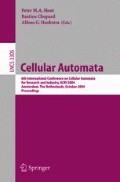Abstract
We outline the basic principles of neuropercolation, a generalized percolation model motivated by the dynamical properties of the neuropil, the densely interconnected neural tissue structure in the cortex. We apply the mathematical theory of percolation in lattices to analyze chaotic dynamical memories and their related phase transitions. This approach has several advantages, including the natural introduction of noise that is necessary for system stability, a greater degree of biological plausibility, a more uniform and simpler model description, and a more solid theoretical foundation for neural modeling. Critical phenomena and scaling properties of a class of random cellular automata (RCA) are studied on the lattice \(\mathbb Z^{2}\). In addition to RCA, we study phase transitions in mean-field models, as well as in models with axonal, non-local interactions. Relationship to the Ising universality class and to Toom cellular automata is thoroughly analyzed.
This research has been funded in part by NSF BITS Grant #0130352.
Access this chapter
Tax calculation will be finalised at checkout
Purchases are for personal use only
Preview
Unable to display preview. Download preview PDF.
References
Grossberg, S.: Nonlinear Neural Networks: Principles, Mechanisms, and Architectures. Neural Networks 1, 17–61 (1988)
Hopfield, J.J.: Neural networks and physical systems with emrgent collective computational abilities. Proc. National Academy of Sciences, USA 79, 2554–2558 (1982)
Elman, J.L.: Finding structure in time. Cognitive Science 14, 179–211 (1990)
Chua, L.O., Hasler, M., Moschytz, M., Neirynck: Autonomous cellular neural networks - A unified paradigm for pattern formation and active wave propagation. IEEE Trans. Circ. Syst. I - Fund. Th. Appl. 42, 559–577 (1995)
Freeman, W.J.: Tutorial on neurobiology - From single neurons to brain chaos. Int. J. Bifurcation & Chaos 2(3), 451–482 (1992)
Freeman, W.J.: Societies of Brains. Lawrence Erlbaum, Mahwah (1995)
Freeman, W.J.: Noise-induced first order phase transitions in chaotic brain activity. Int. J. Bifurcation and Chaos 9(11), 2215–2218 (1999)
Erdos, P., Renyi, A.: On the evolution of random graphs. Publ. Math. Inst. Hung. Acad. Sci. 5, 17–61 (1960)
Bollobas, B.: Random Graphs. Academic Press, London (1985)
Freeman, W.J., Kozma, R., Werbos, P.J.: Biocomplexity - Adaptive Behavior in Complex Stochastic Dynamical Systems. BioSystems 59, 109–123 (2001)
Kauffman, S.A.: Requirements for evolvability in complex systems: orderly dynamics and frozen components. Physica D 42, 135–152 (1990)
Grimmett, G.: Percolation in Fundamental Principles of Mathematical Sciences. Spinger, Berlin (1999)
Balister, P.N., Bollobas, B., Stacey, A.M.: Dependent percolation in two dimensions. Probability Theory and Related Fields 117(4), 495–513 (2000)
Balister, P., Bollobas, B., Stacey, A.: Upper bounds for the critical probability of oriented percolation in two dimensions. Proc. Royal Soc., London Sr., A. 400(1908), 202–220 (1993)
Aizeman, Lebowitz: Metastability effects in bootstrap percolation. Journal Phys. A 21, 3801–3831 (1988)
Duarte, A.M.S.: Simulation of a cellular automaton with an oriented bootstrap rule. Physica A 157, 1075–1079 (1989)
Adler, J., van Enter, Duarte, J.A.: Finite-size effects for some bootstrap percolatioin models. J. Statist. Phys. 60, 322–332 (1990)
Schonmann, R.: On the behavior of some cellular automata related to bootstrap percolation. Ann. Probability 20(1), 174–193 (1992)
Cerf, R., Cirillo, E.N.: Finite size scaling in three-dimensional bootstrap percolation. Ann. Probab. 27(4), 1837–1850 (1999)
Watts, D.J., Strogatz, S.H.: Nature 393, 440 (1998)
Moore, C., Newman, M.E.J.: Epidemics and percolation in small-world networks. Phys. Rev. E 61(5), 5678–5682 (2000)
Newman, M.E.J., Jensen, I., Ziff, R.M.: Percolation and epidemics in a twodimensional small world. Phys. Rev. E 65, 1–7 (2002); 021904
Toom, A.L., Vasilyev, N.B., Stavskaya, O.N., Mityushin, L.G., Kurdyumov, G.L., Prigorov, S.A.: Discrete local Markov systems in Stochastic cellular systems: ergodicity, memory, morphogenesis. In: Dobrushin, R.L., Kryukov, V.I., Toom, A.L. (eds.). Manchester University Press (1990)
Balister., P., Bollobas, B., Kozma, R.: Mean filed models of probabilistic cellular automata (2003) (revised, submitted)
Balister, P., Bollobas, B., Johnson, R., Walters, M.: Majority percolation (2004) (submitted)
Binder, K.: Monte Carlo Methods in Statistical Physics. Springer, Heidelberg (1979)
Makowiec, D.: Stationary states of Toom cellular automata in simulations. Phys. Rev. E 60(4), 3786–3787 (1999)
Kozma, R., Balister, P., Bollobas, B., Chen, H., Freeman, W.J.: Analysis of scaling laws in local random cellular automata (2003) (submitted)
Marcq, P., Chate, H., Manneville, P.: Universality in Ising-like phase transitions of lattices of coupled chaotic maps. Phys. Rev. E 55(1), 2606–2629 (1997)
Freeman, W.J.: Mass action in the nervous system. Academic Press, London (1975)
Kozma, R., Freeman, W.J.: Chaotic Resonance - Methods and applications for robust classification of noisy and variable patterns. Int. J. Bifurcation & Chaos 11(6), 1607–1629 (2001)
Author information
Authors and Affiliations
Editor information
Editors and Affiliations
Rights and permissions
Copyright information
© 2004 Springer-Verlag Berlin Heidelberg
About this paper
Cite this paper
Kozma, R., Puljic, M., Balister, P., Bollobas, B., Freeman, W.J. (2004). Neuropercolation: A Random Cellular Automata Approach to Spatio-temporal Neurodynamics. In: Sloot, P.M.A., Chopard, B., Hoekstra, A.G. (eds) Cellular Automata. ACRI 2004. Lecture Notes in Computer Science, vol 3305. Springer, Berlin, Heidelberg. https://doi.org/10.1007/978-3-540-30479-1_45
Download citation
DOI: https://doi.org/10.1007/978-3-540-30479-1_45
Publisher Name: Springer, Berlin, Heidelberg
Print ISBN: 978-3-540-23596-5
Online ISBN: 978-3-540-30479-1
eBook Packages: Springer Book Archive

